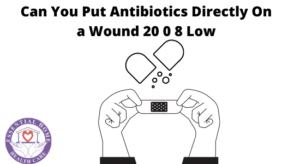Most doctors recommend antibiotics after surgery to put on your wounds. You can also do home health care damage treatment for fast recovery. Antibiotic reduces the risk of surgical wound infection. Prophylaxis is recommended for all contaminated and dirty procedures.

It is optional for most clean systems, but it may be required for certain patients and sanitary practices that meet certain risk thresholds. Antibiotic administration timing is critical for efficacy. The first dose should always be given 30 minutes before the procedure. During the procedure, administration of the antibiotic every one to two half-lives is advised. Postoperative administration is generally discouraged. The most common organism causing wound infection in the process and the relative costs of available antibiotics influence antibiotic selection. This includes oral and intravenous antibacterial agents and mechanical preparation of the bowel for specific gastrointestinal systems. Other procedures can be covered by cefazolin.
Postoperative wound infections significantly impact patients’ quality of life and significantly increase healthcare costs. The consequences for patients range from increased pain and wound care to sepsis and death. Approximately 1 million Americans get incorporated infections every year, extending their hospital stay by one week and costing them 20% more. This adds $1.5 billion to annual health care costs.
Surgical Procedure Classification and Risk Factor Analysis
The chance of infection without antibiotics, as well as the morbidity and cost of an infectious consequence, are factors in determining whether a procedure is “prophylaxis indicated.” A taxonomy that classifies procedures according to the extent of microbial contamination and the possibility of infection helps clarify these difficulties. Infection rates range from less than 2% for clean procedures (e.g., breast biopsy) to over 40% for filthy treatments (colon perforation with diffuse fecal contamination). Antibiotic Prophylaxis is recommended in all systems classified as clean-contaminated, contaminated, or soiled.
Antibiotic Selection and Administration
Antibiotics should be effective against pathogens, reach enough tissue levels, have common adverse effects, be reasonably priced, and not select pathogenic species. Even though the wound’s microbiological ecology and the hospital’s environment may influence the antibiotic selection, coverage should focus on postoperative infections. Staphylococcus species can occur in most treatments that do not involve mucosa or a hollow viscus. Generally, a first-generation cephalosporin meets these characteristics and is sufficient for most surgeries.
Antibiotic for Wound Infection With Pus
The most widely used medication is cefazolin (Ancef, Kefzol). This includes gram-negative and anaerobic microbes found in the gastrointestinal, urinary, and hepatobiliary systems. This is when cefoxitin or cefotetan (Cefotan) are appropriate agents. To cover Staphylococcus, an aminoglycoside and metronidazole (Flagyl) can be employed, while clindamycin (Cleocin) and vancomycin (Vancocin) can cover anaerobic and gram-negative bacteria, respectively. In the same situation, Aztreonam (Azactam) can be used with clindamycin but not metronidazole on quinolones like ciprofloxacin (Cipro) for Prophylaxis against gram-negative bacteria.
Administration timing is essential. The medicine should be given within 30 minutes of the incision, if not two hours. Dose one before making the skin incision. A drug administration interval of one or two times the drug’s half-life is recommended for more lengthy procedures (using the same dose). This maintains sufficient tissue levels throughout the process. Antibiotic half-lives. No longer than the surgical period is required to maintain an adequate tissue level of antibiotics. Extending the administration time is only done in extreme cases such as excessive contamination from a viscus rupture or severe trauma. The present facts do not support extending coverage to 24 to 48 hours in such situations.
Specific Procedure Category Recommendations
Prevention is required for any non-clean operations. As stated previously, certain risk factors need Prophylaxis for clean operations. The following suggestions relate to specific procedures. Notable recent quality standards reports that qualify recommendations based on available supporting evidence are helpful. Can you put antibiotics directly on wounds?
TISSUE CUTANEOUS AND SUPERFICIAL PROCEDURES
Precautions for cutaneous and superficial soft tissue treatments Prophylaxis is acceptable but not strongly recommended for patients with two or more substantial risk factors. In traumatic wounds, check the patient’s tetanus vaccination. Prophylaxis requires mechanical washing and following instructions for open wound management created more than 12 hours before therapy.
PROCEDURE FOR THE HEAD AND NECK
Coverage of aerobic cocci is recommended for procedures entering the oropharynx or esophagus. Prevention has been demonstrated to minimize severe wound infection by half. Penicillin or cephalosporin-based Prophylaxis works. Commonly used is cefazolin. Prevention is not recommended for dentoalveolar surgeries but is required for immunocompromised patients.
NEUROSURGERY TECHNIQUES
Antibiotic Prophylaxis in neurosurgery has had mixed success. The supporting evidence was recently evaluated. Prophylaxis is now advised for craniotomies and shunts. Coverage includes S. aureus and S. epidermidis. Various regimens have been considered, from cefazolin and gentamicin (Garamycin) to cefazolin, vancomycin, piperacillin (Pipracil, Zosyn), and cloxacillin alone (Cloxapen, Tegapen). No single program has been proven superior. Until more data are available, cefazolin treatment is recommended.
GENERAL THORACIC TECHNIQUES
Nearly all thoracic surgeries require Prophylaxis despite the absence of supporting evidence (most evidence is based on studies of pulmonary resection for lung cancer). Although the thoracic bacteria encountered are diverse, most are susceptible to cefazolin, the indicated antibiotic.
HEART PROCEDURES
Prophylaxis against S. aureus and S. epidermidis is recommended for cardiac patients. Although the risk of infection is modest, mediastinitis or sternal wound infection has high morbidity. Numerous studies have investigated penicillin, first-generation cephalosporins, second-generation cephalosporins, and vancomycin antibiotic regimens. Prophylaxis is adequate, although no one regimen has been shown superior. In several circumstances, institutions had very high methicillin-resistant S. aureus or S. epidermidis. Despite this, cefazolin remains a helpful agent. Cardiopulmonary bypass lowers medication elimination; therefore, extra intraoperative doses are rarely required.
Many clinicians recommend Prophylaxis for more than 24 hours or until invasive lines, and chest tubes are removed. Most surgeons prescribe therapy for at least 24 hours. Not suggested nor supported by data is coverage until all pipes and tubes are terminated.
GASTROINTESTINAL TRACT SURGICAL
Most GI operations require Prophylaxis. The amount of anaerobic organisms and their proportion increases along the gastrointestinal tract; therefore, the recommendation relies on the segment entered during the process. There is no evidence to suggest standard Prophylaxis for treatments entering the stomach, duodenum, or proximal small bowel. However, clinical practice has unique situations that affect this recommendation. Any case involving decreased stomach acidity raises the number of bacteria and the risk of wound infection. Prophylaxis is warranted if the patient has previously used antacids, histamine blockers, or proton pump inhibitors. Prevention is also indicated for upper gastrointestinal hemorrhage operations. Because stasis increases bacterial counts, Prophylaxis is required when removing the blockage. Furthermore, the inherent risk of infection in individuals with morbid obesity and advanced cancer is significant enough to require Prophylaxis. Although the local flora is altered in these patients, cefazolin is the preferred prophylactic medication.
Colorectal surgeries have a significant risk of infection, Prophylaxis is strongly advised. Several investigations have shown Efficacy, with infection rates dropping from over 50% to under 9%. Antibiotics target gram-negative and anaerobic microorganisms. Oral purgatives like polyethylene glycol, mannitol, or magnesium citrate are used with mechanical bowel preparations like enemas.
The pretreatment reduces feces bulk but not bacterial concentration. In reality, mechanical preparation alone still increases infection risk by 25-30%. 26,27 So, further Prophylaxis is advised. Intraluminal (oral) prophylaxis against aerobic and anaerobic bacteria (given the day before surgery) or parenteral antibiotics (just before surgery) are options. Intraluminal antibiotics reduce infection risk to 9% or less, similar to parenteral antibiotics alone.
For any assistance, you can contact essential home health care that has wound care specialist Chicago. For more info, call (847)813-6301).
